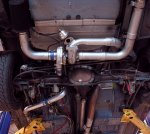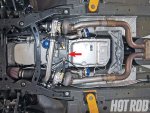The further away from the engine the longer it takes for the exhaust gasses to travel. Also the surface area of the exhaust will certainly lower the inlet temps into the turbo. A Turbo uses the thermal energy of the exhaust to spin, not just the velocity of the exhaust itself. Now to clarify another statement. Having the turbo not in the engine bay could possibly decrease inlet air temps, that could result in lower EGTs and better operation. But the same can be done by simply ducting the turbo inlet to just fresh air.
Now consider mounting the turbo under the tub where the muffler is. There's probably 15ft of exhaust for it to pass through, then another 15ft of duct to return to the intake. The biggest issue with remote mounted turbos like this is the delay this naturally causes. Another thing to consider is inlet air. Most cars that hide the turbo under the cars also have the air filter down there on the turbo as well. For a street car or something not driven in the rain, no biggie. But not at all what a HMMWV is for. You'd need to then duct inlet air down there for another 15ft of piping. Or pull it up into the tub. (I can't recommend that though, a screeching turbo right there in the cabin with you along with intake noise is going to get old)
Understand also how a diesel works. The injection pump simply dumps in fuel as requested. There's no throttle valve on a diesel to control RPM. The engine simply increases RPM based on the fueling presented. So when you mash on the pedal, the pump just meters out more fuel per injection, then the engine spins up (or maintains speed if load has increased). When you add in a turbo to the mix, the turbo's response is based solely on it's characteristics to the exhaust and it's compressor flow. You can have a greatly oversized turbo that could flow all sorts of air, but if the engine can't spool the turbo, you'll never see the boost increase and cleaning up of the exhaust. The black soot you see is unburnt fuel that goes hand in hand with EGT. The way to clear that up is to decrease fueling, the turbo "spools" and air flow is improved, or the engine RPM needs to be increased to flow more air. The engine RPM can be increased by downshifting, but if you're locked into top gear, the turbo isn't going to spool and EGTs soar way out of control.
I'm dealing with the later in a way on my CRD. It has a VGT (variable vane) turbo. These turbos have a tendency to stick the vanes. Mine sometimes sticks at the higher position where more drive pressure is bypassed. This causes low boost at low RPMs and excessive EGTs. I really need to pull the turbo and try cleaning the vanes.




